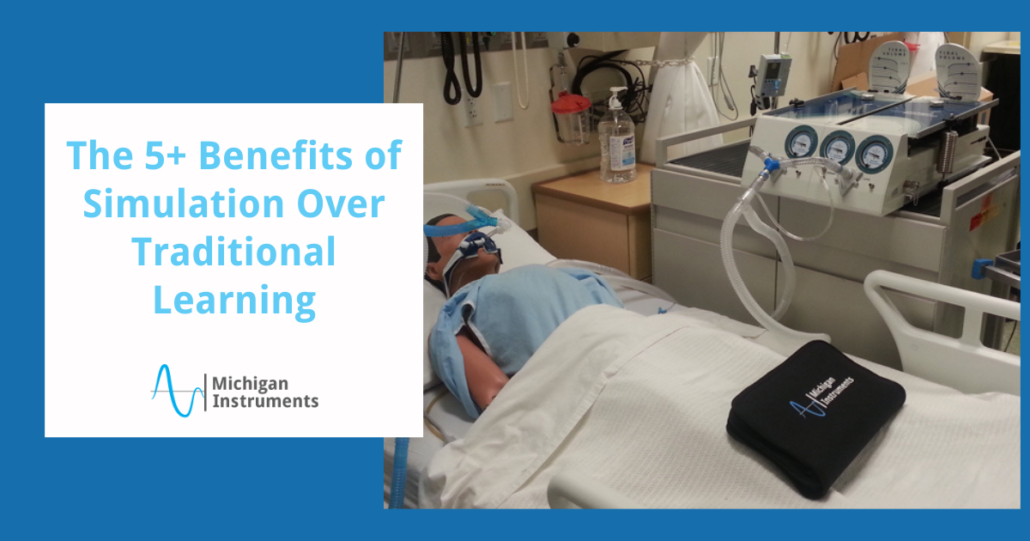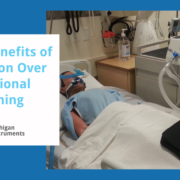
Saving lives is the most important thing in healthcare and emergency medical services. This is why huge advancements have been made in medical education, including simulation over traditional classroom learning.
“In medicine, simulation offers good scope for training of interdisciplinary medical teams. The realistic scenarios and equipment allows for retraining and practice till one can master the procedure or skill… Teamwork training conducted in the simulated environment may offer an additive benefit to the traditional didactic instruction, enhance performance, and possibly also help reduce errors.” [1]
Below, we outline the top 6 benefits of simulation, and how it compares to traditional learning.
1. Bridges the Gap Between Training and Reality
Simulation improves both patient care and outcomes by providing more real-life scenarios for aspiring Respiratory Therapists and EMS Professionals.
Practicing techniques and clinical skills, such as administering oxygen, is made easier with a simulation device that moves and “breathes” like a real human lung or lungs when ventilated.
2. Simulation Ensures Patient Safety
Rather than practicing on live patients, simulation-based education ensures patient safety by allowing mistakes and the ability to correct them.
Many lung simulators are simple at best, which isn’t ideal for real-life patient safety. By using a solid simulator that can mimic the realistic mechanics of the human pulmonary system (such as our Lung Simulators), medical students and professionals alike can perfect their skills without the burden of life vs. death hanging over their shoulders.
Interested in learning more about our Lung Simulators? Contact us to receive a quote and more information today!
3. Safely Prepares for a Variety of Patient Scenarios
A simulation device should offer a range of calibrated lung compliance and airway resistance settings giving students and professionals an immersive, nearly hands-on experience. This allows the replication of hundreds of both healthy and diseased lung conditions, while providing accurate data to inform your testing, research and training.
Our Lung Simulators are available in three models: Single Adult, Dual Adult and Adult-Infant. With three models for students and professionals to choose from, this allows for the ability to simulate a wider variety of patient sizes and health situations, thus improving techniques that will be used in real-life patient scenarios.
4. Reduced Errors in Training = Improved Patient Care
“To Err Is Human”, a report released by the Institute of Medicine (IOM) in 1999, revealed that medical errors result in a minimum of 44,000 and perhaps as many as 98,000 deaths per year in the United States.
This landmark report called for improved training among medical students through a variety of ways, including simulation-based education. While the COVID-19 pandemic has forced universities and training centers to largely discontinue traditional classroom learning, simulation-based education has risen with its remote, digital education component.
Interested in learning more about our Lung Simulators? Contact us to receive a quote and more information today!
5. Teaches Both Students and Professionals Communication Skills
The healthcare industry is moving towards a multidisciplinary team to deliver prime patient care. Therefore, possessing excellent communication skills is just as important as clinical skills for both Respiratory Therapists, EMS Professionals, and Surgeons alike.
In particular, Respiratory Therapists are moving toward a patient-centered approach that can improve the management of diseases, such as Asthma, while also focusing on disease prevention and health promotion for patients.
6. Allows the Reassessment of Any Scenario to Identify Ways to Improve
As mentioned above, simulation-based education allows for students to make mistakes (and correct them) without compromising a real-life patient’s health.
Designed with our users’ needs in mind, our PneuView Software accurately provides numeric and graphical data from our Lung Simulator devices in real time. Additionally, you can save and export data for later review and analysis. This is especially useful for documentation of testing, or when access to certain ventilation technology is not always available.
Interested in learning more about adding one of our Lung Simulators to your classroom, training program or research facility? Contact us to receive a quote and more information today!
(1) Lateef F. Simulation-based learning: Just like the real thing. J Emerg Trauma Shock. 2010;3(4):348–52.




